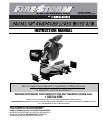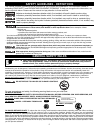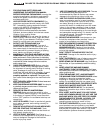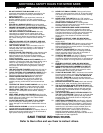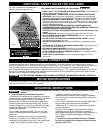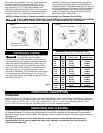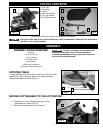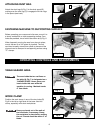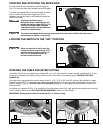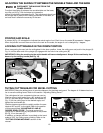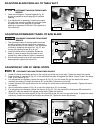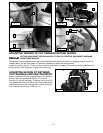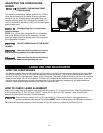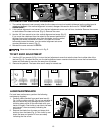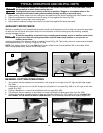
4
ADDITIONAL SAFETY RULES FOR MITER SAWS
Refer to them often and use them to instruct others.
FAILURE TO FOLLOW THESE RULES MAY RESULT IN SERIOUS INJURY.
SAVE THESE INSTRUCTIONS.
1. DO NOT OPERATE THIS MACHINE until it is
completely assembled and installed according to the
instructions. A machine incorrectly assembled can
cause serious injury.
2. OBTAIN ADVICE from your supervisor, instructor, or
another qualified person if you are not thoroughly
familiar with the operation of this machine. Knowledge
is safety.
3. FOLLOW ALL WIRING CODES and recommended
electrical connections to prevent shock or electrocution.
4. SECURE THE MACHINE TO A SUPPORTING SURFACE.
Vibration can possibly cause the machine to slide, walk,
or tip over, causing serious injury.
5. USE ONLY CROSSCUT SAW BLADES. Use only
zero-degree or negative hook angles when using
carbide-tipped blades. Do not use blades with deep
gullets. These can deflect and contact the guard, and
can cause damage to the machine and/or serious
injury.
6. USE ONLY BLADES OF THE CORRECT SIZE AND
TYPE specified for this tool to prevent damage to the
machine and/or serious injury.
7. USE A SHARP BLADE. Check the blade to see if it
runs true and is free from vibration. A dull blade or a
vibrating blade can cause damage to the machine
and/or serious injury.
8. INSPECT BLADE FOR CRACKS or other damage prior
to operation. A cracked or damaged blade can come
apart and pieces can be thrown at high speeds,
causing serious injury. Replace cracked or damaged
blades immediately.
9. CLEAN THE BLADE AND BLADE FLANGES prior to
operation. Cleaning the blade and flanges allows you to
check for any damage to the blade or flanges. A
cracked or damaged blade or flange can come apart
and pieces can be thrown at high speeds, causing
serious injury.
10. USE ONLY BLADE FLANGES specified for this tool to
prevent damage to the machine and/or serious injury.
11. CLEAR THE AREA OF FLAMMABLE LIQUIDS and/or
gas prior to operation. Sparks can occur that would
ignite the liquids and cause a fire or an explosion.
12. CLEAN THE MOTOR AIR SLOTS of chips and
sawdust. Clogged motor air slots can cause the
machine to overheat, damaging the machine and
possibly causing a short which could cause serious
injury.
13. TIGHTEN THE TABLE CLAMP HANDLE and any other
clamps prior to operation. Loose clamps can cause
parts or the workpiece to be thrown at high speeds.
14. NEVER START THE TOOL with the blade against the
workpiece. The workpiece can be thrown, causing
serious injury.
15. KEEP ARMS, HANDS, AND FINGERS away from the
blade to prevent severe cuts. Clamp all workpieces that
would cause your hand to be in the “Table Hazard
Zone” (within the red lines).
16. ALLOW THE MOTOR TO COME TO FULL SPEED
prior to starting cut. Starting the cut too soon can
cause damage to the machine or blade and/or serious
injury.
17. NEVER REACH AROUND or behind the saw blade. A
moving blade can cause serious injury.
18. NEVER CUT FERROUS METALS or masonry. Either of
these can cause the carbide tips to fly off the blade at
high speeds causing serious injury.
19. NEVER CUT SMALL PIECES. Cutting small pieces
(where your hand would be within 6” of the saw blade)
can cause your hand to move into the blade, resulting
in serious injury.
20. NEVER LOCK THE SWITCH in the “ON” position.
Setting up the next cut could cause your hand to move
into the blade, resulting in severe injury.
21. NEVER APPLY LUBRICANT to a running blade.
Applying lubricant could cause your hand to move into
the blade, resulting in serious injury.
22. DO NOT PERFORM FREE-HAND OPERATIONS
(wood that is not held firmly against the fence and
table). Hold the work firmly against the fence and table.
Free-hand operations on a miter saw could cause the
workpiece to be thrown at high speeds, causing
serious injury. Use clamps to hold the work when
possible.
23. PROPERLY SUPPORT LONG OR WIDE WORK-
PIECES. Loss of control of the workpiece can cause
serious injury.
24. AFTER COMPLETING CUT, release power switch and
wait for coasting blade to come to a complete stop
before returning saw to raised position. A moving blade
can cause serious injury.
25. TURN OFF THE MACHINE and allow the blade to
come to a complete stop prior to cleaning the blade
area or removing debris in the path of the blade. A
moving blade can cause serious injury.
26. TURN OFF MACHINE and allow the blade to come to
a complete stop before removing or securing
workpiece, changing workpiece angle, or changing the
angle of the blade. A moving blade can cause serious
injury.
27. PROPERLY SUPPORT LONG OR WIDE WORK-
PIECES. Loss of control of the workpiece can cause injury.
28. NEVER PERFORM LAYOUT, ASSEMBLY, OR SET-UP
WORK on the table/work area when the machine is
running. A sudden slip could cause a hand to move
into the blade. Severe injury can result.
29. TURN THE MACHINE “OFF”, disconnect the machine
from the power source, and clean the table/work area
before leaving the machine. LOCK THE SWITCH IN
THE “OFF” POSITION to prevent unauthorized use.
Someone else might accidentally start the machine and
cause injury to themselves.
30. BEFORE OPERATING THE SAW, check and securely
lock the bevel, miter, and sliding fence adjustments.
31. THE CUTTING HEAD MUST RETURN QUICKLY TO
THE FULL UP POSITION. Failure to do so will not allow
the lower guard to operate properly and may result in
personal injury. See manual section on “Adjusting the
Cuttinghead Return”.
32. THE CUTTING HEAD MUST RETURN QUICKLY TO
THE FULL UP POSITION. Failure to do so will not allow
the lower guard to operate properly and may result in
personal injury. See manual section on “Adjusting the
Cuttinghead Return”.
33. ADDITIONAL INFORMATION regarding the safe and
proper operation of power tools (i.e. a safety video) is
available from the Power Tool Institute, 1300 Sumner
Avenue, Cleveland, OH 44115-2851 (www.powertool
institute.com). Information is also available from the
National Safety Council, 1121 Spring Lake Drive,
Itasca, IL 60143-3201. Please refer to the American
National Standards Institute ANSI 01.1 Safety
Requirements for Woodworking Machines and the U.S.
Department of Labor regulations.



